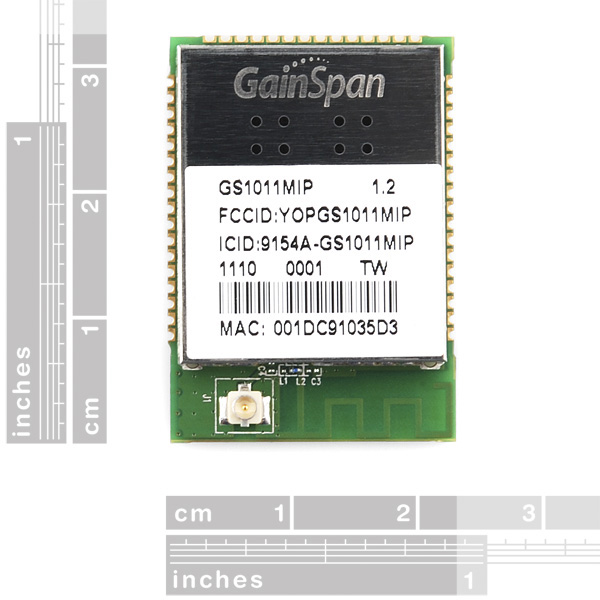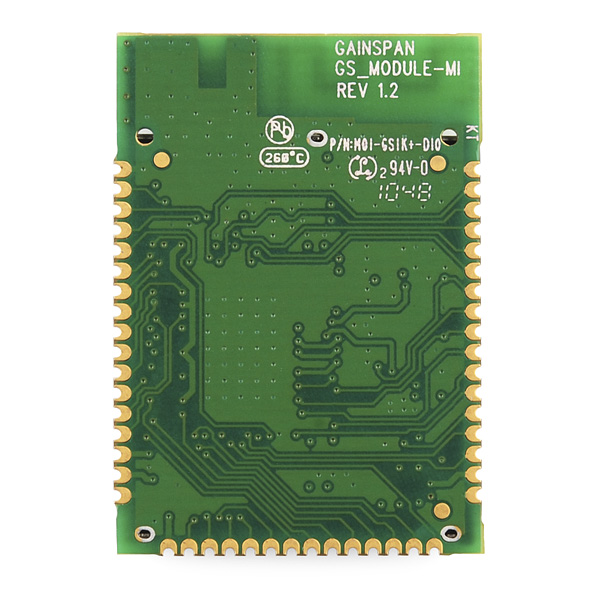GainSpan Module
Replacement: None. We don't carry a direct replacement for the GainSpan module, but check out the WiFi category for some other 802.11b/g wireless modules. This page is for reference only.
The GS1011 module is a highly integrated ultra low power wireless single chip which contains an 802.11b radio, media access controller (MAC) and baseband processor, on-chip flash memory and SRAM, and an applications processor all on a single package. Along with its embedded software stack it offers a highly scalable, reliable, manageable and secure wireless link to meet the growing demand of wireless sensor networks utilizing the broadly accepted IEEE 802.11b,g,n standards infrastructure.
- Supports IEEE 802.11
- Seamlessly integrates with existing 802.11b/g infrastructure and utilizes the 802.11 security, manageability, ease-of-use, and quality of service
- 802.11i/WPA2 Authentication, AES Hardware encryption
- Optimized for battery powered application with very low power consumption for multiple years of battery life
- PCB antenna: Range 200-300M+ Outdoor (Typical Estimate)
- Two 32-bit ARM7 CPU @44MHz, 1 for applications (APP) : 1 dedicated to radio (WLAN)
- 2 UART , I2C, 2 SPI, 2 ADC, 3 PWM, and 32 GPIO
- Operates at 3.3V
Comments
Looking for answers to technical questions?
We welcome your comments and suggestions below. However, if you are looking for solutions to technical questions please see our Technical Assistance page.
Customer Reviews
No reviews yet.





wow I think I never saw a better cost/benefit ratio for low volume embedded wifi... impressive
Is this thing useless without signing an NDA? Where can I find the documents?
EDIT: I found the serial-to-WiFi document with a little Googling. Hint: the filename is "Serial_to_WiFi_Adapter_Guide"
Here's some more info: http://forums.netduino.com/index.php?/topic/2184-netduino-wifi/
Do you know if the app cpu is user programmable? It seems that the manual just describes how to use these nice features externally but not programatically from the APP cpu.
It would be nice if they leave space in the APP cpu for a user program. That would make this module self-contained for a very good price.
Hi grodrig,
It seems the APP CPU is programmable. They also leave 256KB of flash for the APP CPU. However, the 128K of RAM is shared between the WLAN CPU and the APP CPU. You can program the module with JTAG, However i cannot tell you how to, since it's protected under a NDA i signed. You will need to register and sign the same NDA, Then will you be able to access to AN-011 from GainSpan.
My opinion is that Sparkfun should have never stocked this product because of the lack of a publicly available SDK and tools. A better module would be this
Regards,
MattTheGeek
As far as I can see the Microchip module is not programmable, it uses a SPI interface. So, this module is the same, the documents provided by sparkfun will give you ability to use the serial interface.
This module is also a bit cheaper, has an intergrated network stack leaving you free to choose a non microchip cpu and have a lower memory requirement.
It can also be programmed, you do need to sign an NDA for the docs on that though.
If you do choose to sign the NDA you have a ARM7 at 44mhz that you can use. Devboards with only that goes for much more than this module.
I had the same reaction... Sparkfun's had a whole parade of wifi and bluetooth modules that "can" run user code according to the product page, but it turns out only if you sign NDAs, buy an expensive SDK, or buy the modules in quantity from a different distributor... sigh.
I do want to mention that this is designed to be a WiFi module first and foremost and for out of the box use. Try not to assume you can write your own code for it. If I remember correctly, all the other WiFi and Bluetooth modules state that they can be programmed by the user. Just do a bit more research and you will find what you need.
If the description is unclear about certain aspects, let SFE know so they can fix it.
Some can. However, This states it has both a baseband processor and a user program processor, so it might mislead some.
I see no "user program processor," I see "application processor." And for all we know about it is that the baseband processor and application processor are both proprietary systems with their code running on them. In no way shape or form is there anything misleading that says this is a "user program processor."
Can I send email to someone using this device?
Does anyone using this module as spi slave? I cannot communicate with this module at all.
Looks like a very nice product. I wonder if I can use it for robot control (with video streaming and telemetry command over the air). Anyone has used this for such purposes? Thanks.
In case anyone is wondering, this won't do (slave) SPI out of the box. The bundled 2.2.x "S2W" firmware enables only the UART, although you can get it to go at the advertised 921600 bauds, along with hardware handshaking. Still pretty decent, if you have a spare UART on your uC.
One interesting tidbit of info for potential buyers though: read the changelog for all the documents. Most docs relate to the 2.3.x series firmware, and some to the 2.5.x (see Laird Tech's WLM100 / WLM101 cough). Most of the errors with AT commands reported in earlier comments here can be traced to this mismatch in onboard firmware revision and documentation.
And there's no way around it: if you want an updated firmware, even in binary form, you have to sign the NDA. Gainspan Support did hint not-so-subtly that I should have bought the EVK outright, but get this: it comes with various flavours of binaries all based on the 2.2.x firmware. Bam: NDA required again.
Bottom line: this is still a nice little module which gives you a UART at one end and WiFi at the other. Lots of network APIs too. If you want updated firmware: buy the EDK and sign the NDA. If you want to enable those I2C, SPI, PWM ports: you'll need the SDK.
I am a FPGA end developer interested in the wifi capability of the GS1011 module. My application requires two sockets, one for continuous data streaming output (throughput ~= 1mbps), the other for specific control commands and response. Based on the GS1011 user manual, I can either use uart0 & uart1 or slave spi & uart0. May I understand if it is possible to transmit data into two uart ports simultaneously? Besides I have already developed drivers for both master spi and slave spi and achieved internal loopback. Is it possible to transmit data into the slave spi port with the default firmware? Thank you very much.
I'm looking for the exact same thing! Have you found a simple way to do this with any wifi module?
Well Looking at the schematic of the breakout and the datasheet of the module, i think it can work fine with arduino just like this:
UART0-RX-GPIO0 - ARDUINO D1
UART0-TX-GPIO1 - ARDUINO D0
VIN3V3 - ARDUINO 3v3 pin
GND - ARDUINO GND
VBAT - ARDUINO 3v3 pin too
EN1v8 - ARDUINO 3v3 pin too
And i can put the 2 leds on the GPIO30-LED1 GPIO30-LED2 and the GND from arduino.
On Arduino use Serial.begin() and start communicating via UART.
If incorrect please tell me cus when the module arrives i will try use this 'schema' to run it.
ty
Did this work for you?
The product dont arrived here yet.....
iam waiting and when it arrives, i will answer you.
Hi Robert, thankyou for aswering.
But i have buy the 10808 to use with arduino, will not work?
if not, can you tell me if i can buy just the red board from 10505 ?
Thank you.
Sorry the question but this can by easly wired direct to the arduino too?
ty
You might want to check out the breakout below.
Is this module the extended range E version or the low power I version? Is the PCB antenna connected or the ufl connector or can a person use either one? Do the answers to these questions apply in the same way to the WRL-10505 GainSpan WiFi Breakout?
Sorry if I missed the answers on this page. Searched and could find them anywhere.
The module is the GS1011MIP, so it is the low power 'I' version and it uses the PCB antenna, the ufl connector is disabled. This also applies to WRL-10505.
Excelent module with lot of potencial for low cost also has HTTPS/SSL support!
Any tutorial to enable SSL connections? How to get a certeficate and configure it?
Regards
Anyone know if it supports adhoc connection?
Look at page 50 of the "command set" document linked to above. It (very briefly) describes setting up either ad hoc networking, or AP mode. For my purposes, AP mode is much more useful. I've had extremely variable luck (mostly of the bad variety) trying to get ad hoc networking going with various devices. I'm hoping this device is simple to set up in AP mode and is reliable. The documents would lead you to believe you can do ad hoc networking... but it may not play nice with whatever device you have on the other end.
Looks like loads of potential, specially with the app cpu. Added to my next basket :)